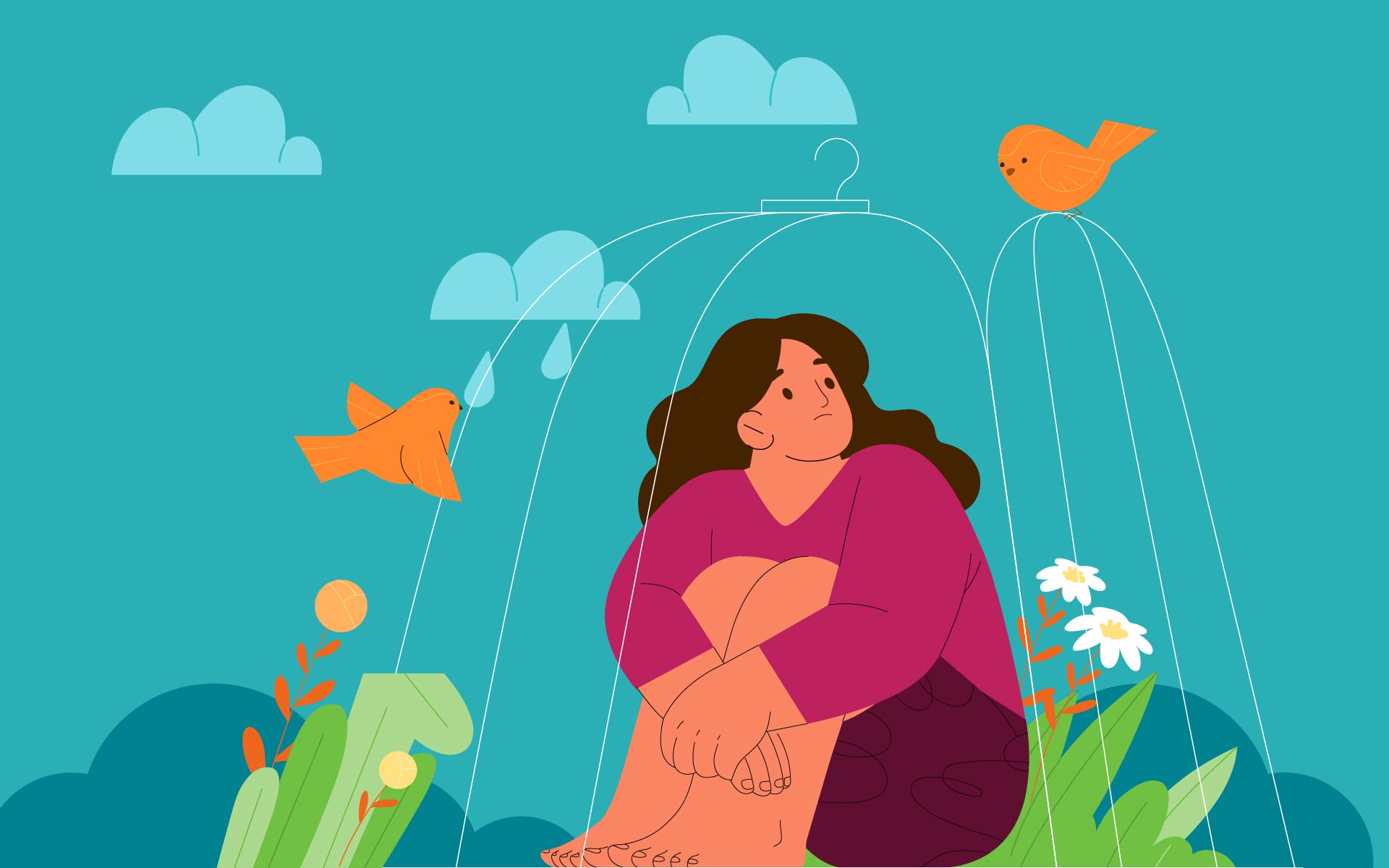Between a stimulus and response there is a space. In that space is our power to choose our response. In our response lies our growth and our freedom. —Viktor Frankl
How you respond to the issue…is the issue. —Frankie Perez
When I worked in the Sunset neighborhood of San Francisco, I would park my car in Golden Gate Park and walk the two blocks to my office, something I could easily do on automatic pilot.
One day, more distracted than usual by mulling over something I was worried about, I wasn’t paying enough attention to where I was walking and blithely stepped into a sidewalk of freshly laid wet cement—up to my ankles.
The cascade of critical thoughts erupted immediately. “You stupid klutz! Look what you’ve done! You’ve ruined your shoes! Now you’ll be late to work. You’ll have to cancel clients today. You’ll probably lose clients over this. How could you!” An instant slide into a deep rabbit hole of shaming-blaming-catastrophizing.
Fortunately, by then I had enough mindfulness and self-compassion practices under my belt to catch up to myself. “Whoa! Wait a minute! I need to do this differently! I’m not the only person on the planet who made a mistake today just because they weren’t paying attention. This is probably not the only mistake I’m going to make today. I need to slow down here, collect myself, try to be a little kinder to myself right here, right now. I need to step out of this sidewalk, and deal.”
With that shift in attitude and shift in response, I gently picked my feet up out of my shoes and picked my shoes up out of the cement.
There happened to be an apartment building with an outdoor water faucet just a few steps away. As I washed off my shoes, I began to think a little more clearly. “This happened. Other than my own embarrassment and my own inner critic wailing the hide out of me, there’s no catastrophe here. Shit happens. I’m dealing with it as best as I can. This is going to be OK.”
When an on-site construction worker came over to me with some paper towels to wipe off my shoes (I’m grateful to this day for his kindness—no teasing or taunting, no further embarrassment), I began to have some hope that I could save my shoes. I also began to have a little pride and a lot of gratitude that I was coping as well as I was.
Then came the big shift. “Yeah, shit happens, but shift happens, too. If I can shift my attitude in this moment, I can shift my attitude in any moment.”
Then came the big shift. “Yeah, shit happens, but shift happens, too. If I can shift my attitude in this moment, I can shift my attitude in any moment.”
Bouncing back from disappointment, difficulty, even disaster, simply means using the response flexibility innate in our brains to shift gears, shift perspectives, see options that we couldn’t see before. Response flexibility allows us to shift out of our very automatic, habitual, and quick reactivity into a more skillful responsiveness.
By shifting our response, we become more resilient; we learn and grow; we recover our well-being.
We strengthen our capacity to create a shift in our responses to challenging life events, even potential crises, by mindfully, compassionately paying attention to our reactivity.
Watch Your Reactivity
I was working in my San Francisco office one day, seeing the individuals and couples I counsel in my psychotherapy practice. On a long break, I was sitting there, quietly meditating, but I had left the ringer of my phone on because I was expecting a phone call with the results of my most recent mammogram. When the call came with the results—“There’s a slight abnormality on the x-ray. Could you come in and have the mammogram done again?”—my anxiety went right through the roof. Thoughts immediately sprang to mind of two friends who’d recently had surgery, radiation, and chemotherapy for their breast cancer.
Because I had been meditating just the moment before, I had enough calm and clarity to watch my anxiety soar, to watch those thoughts rapidly spill over each other. I could see my reactivity. I could see my reactivity to my reactivity. My hand went to my heart immediately. I even said to the nurse on the phone, “I’m breathing. I’m b-r-e-a-t-h-i-n-g.” Then I scheduled the second appointment and sat back down to meditate again.
Being compassionate to myself as the experiencer of the fear, opening out to my connection to others, my common humanity, I thought, “I’m not alone. I’m not the only one.” I also appreciated the resources I would need medically and emotionally and that I would be able to access. Appreciating these resources and connections counteracts the tendency to see oneself as a lone victim of circumstances.
The results of the second mammogram later were fine. My practice allowed me to return to a sense of presence and equanimity even before I knew those results, and had they been worse, I would have been in a better position to deal with that.
The Hand on Heart practice provides a means to shift back to being present when you start spiralling into fear, self-doubt, and self-criticism.
Be Kind to Yourself
Last winter a huge thunderstorm blew out the power transformer on my block—no electricity for 36 hours—no heat, no lights, no refrigerator, no stove, no phones, no internet.
I managed to handle things fairly well, staying calm and creative in my coping, until the morning of the second day when I automatically wanted to check emails on my computer. I was aware of my rising frustration and my deepening contraction around the frustration. I was losing my clarity, becoming more reactive and angry when I walked through the kitchen and noticed a magnet on my refrigerator with the words: “May I give myself the compassion I need.” Right. I teach this stuff. So I stopped in front of the refrigerator and began reciting the mindful self-compassion phrases I teach to many others (see the self-compassion practice). These (and the Hand on Heart practice) are drawn from the Mindful Self-Compassion protocol developed by Kristin Neff and Christopher Germer.
By the time I had repeated those phrases a few times, slowly, thoughtfully, I could feel my mind expanding back from its contraction to a more open perspective. (You can feel this physically in your body—shifting from tightness and tension to openness and relaxation.)
“I have internet at my office! That’s only 10 minutes away.”
When I was in my contracted, frustrated state of mind, I couldn’t think straight. Repeating the mindful self-compassion phrases to myself broke the automaticity of my reactivity and allowed me to see the larger picture again.
It’s not that mindful self-compassion solves the problems of the moment. It doesn’t. Self-compassion and other positive emotion practices—gratitude, awe, generosity, joy, delight, serenity, love—simply shift the functioning of the brain to put us in a better position to solve the problem.
Shift happens when we intentionally choose to focus our awareness on the experience of compassion, gratitude, warmth, and other feelings that put us in touch with our natural resilience. These practices can shift the functioning of the brain instantly. Over time, these practices become steadily more reliable, the new “go to” when we are navigating the twists and turns of life. Mindful self-compassion shifts the possibilities of our responses instantly, in this moment, in any moment, and over time in every moment. Being kinder to ourselves becomes natural and effortless.
See Clearly
The need to feel connected to other human beings, to be seen, to have a sense of belonging, is so powerfully hard-wired by evolution into our brain’s circuitry that we can instantly feel the pain of disconnection from others, and then we can spin our own automatic stories about what that disconnect, or our reactions to it, might mean.
Mindful self-compassion practices allow us to be kind and caring to ourselves in the moment of any reaction to any event in any relationship, recovering our equilibrium and openness to the moment, allowing us to see our reactions clearly and make wise and resilient choices about how we relate to ourselves and to others.
A useful tool in helping to achieve this natural “self-righting” is the guided visualization, which I learned from Stuart Eisendrath, who studies mindfulness and depression at the University of California, San Francisco medical school.
Practices of mindfulness and self-compassion together allow us to make the wisest choices possible. We can shift our patterns of response to difficult, even adverse, life events, from confusion and reactivity to intentional openness and reliable clarity. Yes, shit happens—but shift happens, too. In this moment. In any moment. In every moment.
How to Shift Mental Gears: 2 Practices for Building Resilience
1) Practice: Hand on Heart
 This practice can help you respond skillfully to distressing events. You can do it quickly, many times a day if need be, to bring a calming awareness to your experiences. Simply stop—pause—and:
This practice can help you respond skillfully to distressing events. You can do it quickly, many times a day if need be, to bring a calming awareness to your experiences. Simply stop—pause—and:
- Place your hand over your heart so that you feel the warm touch of your hand on your chest.
- Begin to breathe more slowly, more gently, more deeply, into your heart center.
- Recall a moment, just one moment, when you felt safe, loved, and cherished by another human being. (With practice, evoking this memory can happen instantly, too.) Not the entire relationship, just one moment. This could be a moment with a spouse or a parent or a child. It could be a moment with a friend, a therapist, a teacher, or even a beloved pet.
- As you remember this moment, let its warmth wash through your body; savor this feeling for 30 seconds.
- When you are ready, reflect on any shift you felt in your body from this practice.
2) Noticing Emotional Responses
- Sit or lie down in a relaxed and comfortable position. Generate a kind and loving awareness of being present in your body in this moment in this place.
- Imagine you’re walking on a sidewalk on a street in your hometown, someplace that feels familiar and comfortable to you.
- On the opposite side of the street, walking in your direction on the opposite sidewalk, you see someone you know and recognize. You wave and call out “Hello,” but there’s no response. In that instant, note your own response. Notice any contraction, disappointment, reactivity on your part.
- Now, change the scenario. Instead imagine that on his or her own, the person sees you and recognizes you instantly and waves and calls out “Hello!” Notice your own immediate response to the greeting.
- Take a moment to reflect on any differences you noticed in your responses between when you were recognized and when you were not.




